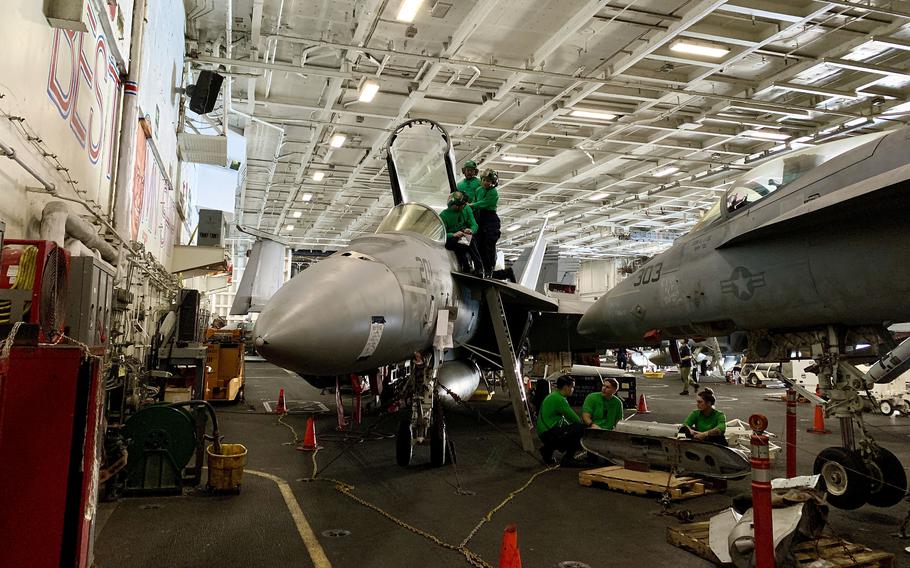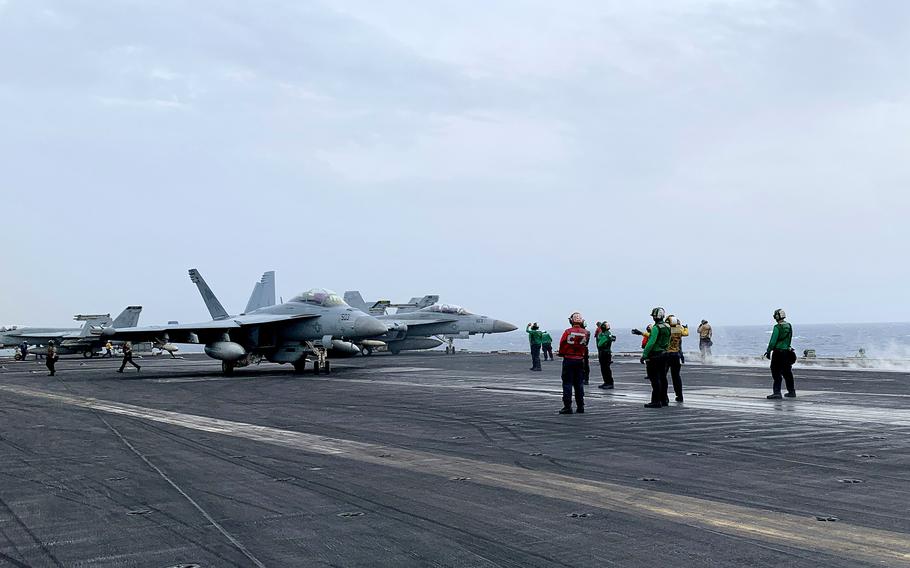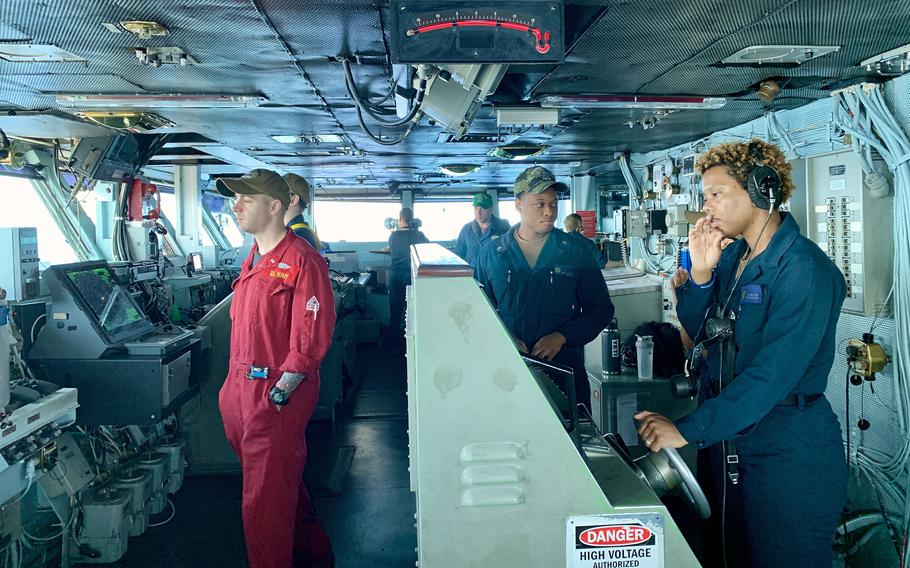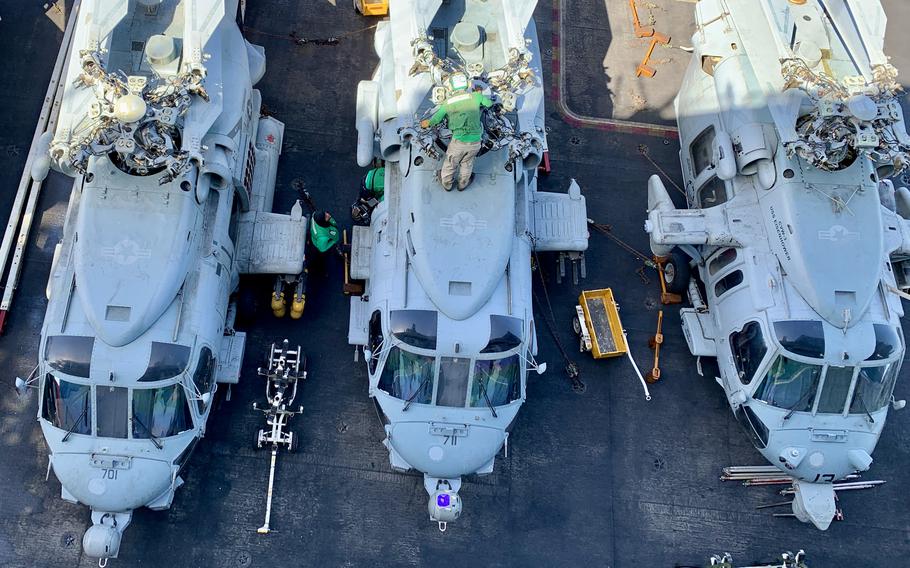
Sailors work on an F/A-18 Super Hornet in the hangar bay of the aircraft carrier USS Dwight D. Eisenhower on March 20, 2024. About 5,000 sailors are assigned to the deployed ship. (Alison Bath/Stars and Stripes)
ABOARD THE USS DWIGHT D. EISENHOWER — A chocolate chip cookie is helping the U.S. Navy sustain 5,000 sailors aboard this aircraft carrier as they work to stem Iranian-backed Houthi militants determined to disrupt shipping in the Red Sea.
That now-famous cookie is bestowed daily by Capt. Chris Hill, the ship’s commanding officer, to unsuspecting sailors and chronicled on X, formerly known as Twitter, for the world to see.
It isn’t just a treat. It’s sweet recognition, tangible evidence that Hill and other commanding officers across 20 departments on the Eisenhower value and appreciate the sailors’ individual contributions, no matter their rank or rate.
“I want the world to see what these young folks are doing,” said Hill, whose X account, @ChowdahHill, has more than 66,200 followers. “It’s amazing.”
In other words, their jobs, no matter how seemingly unrelated to the F/A-18 Super Hornets and other aircraft that take off from the carrier day and night, are vital to the mission.
“If I’m going to create morale, I need to make sure that everyone feels loved and valued,” Hill said. “I need to make sure everybody has a mission of purpose.
“I need to create winning environments. This creates morale; morale leads to success.”
Building and maintaining that esprit de corps isn’t easy for any manager, military or otherwise, even in the best of circumstances. But the job is made harder by an unrelenting operational tempo, which has kept the Eisenhower at sea for nearly five months without a port call.
That’s not normal. Typically, carriers make port calls every 30 to 45 days to give sailors needed stress relief from their jobs.
But since Dec. 31, Eisenhower has launched about 100 flights daily, six to seven days a week for a variety of missions, such as intercepting Houthi missiles and drones, destroying the group’s military sites in Yemen or defending the ship.
The carrier, along with accompanying destroyers and other units, also is under threat of near-daily Houthi attacks. For example, the destroyer USS Laboon was targeted by a close-range ballistic missile attack on March 12.
There were no injuries, and the ship wasn’t damaged, U.S. Central Command said at the time.
While the Navy is built for this type of combat, sustaining those operations for months without a port call is unusual — and grueling, officials said.

Flight deck crew members ready an EA-18G Growler electronic warfare plane for launch from the aircraft carrier USS Dwight D. Eisenhower on March 19, 2024. (Alison Bath/Stars and Stripes)
Absent the diversion, Eisenhower officials have worked to improve the quality of sailors’ lives in other ways, notably with the addition of onboard Wi-Fi.
The capability allows the crew to talk more regularly with family and friends via WhatsApp or Facetime while allowing other internet access.
While many Navy ships offer internet, access can be limited. Outside a port call, sailors can find it challenging to send emails, post on social media or make a phone call to stay in touch with family and friends.
For Hill, the addition of Wi-Fi was a game changer. It offered an opportunity not only to shout out sailors for their accomplishments but also to connect with their families.
It also was a way to showcase to a wider audience the capabilities of crew members, many tasked with significant responsibilities, such as “running a nuclear power plant on an aircraft carrier in a combat zone,” Hill said.
Careful attention also is paid to ensuring that sailors are scheduled to get about eight hours of sleep daily. Emergencies, alert launches and other problems can sometimes interfere with that goal, Hill noted.
Getting adequate rest “is important because if you don’t get good sleep … your response time decreases, your mood decreases; it affects relationships; it starts to break down unit cohesion,” Hill said.
He added that a better strategy “is to take away the enemy’s sleep, not our own sleep.”

Sailors man the bridge on the aircraft carrier USS Dwight D. Eisenhower on March 20, 2024. Most of the ship's sailors are 18 to 24 years old and have jobs with significant responsibilities, such as driving the ship or maintaining its nuclear power system. (Alison Bath/Stars and Stripes)
Servicewide, shipboard sailors on average get about 5.25 hours of sleep, well below the minimum 7.5 hours required by policy, according to a Government Accountability Office report released in October.
The report found that the Navy still hadn’t remedied high workloads caused by undercrewing and poor-quality mattresses, two of the biggest causes of sailor fatigue, Stars and Stripes reported at the time.
In addition to Wi-Fi, the ship holds hundreds of events, such as art sessions, bingo and a singing competition.
The ship also tries to set aside a day each week or every two weeks to allow sailors access to the deck so they can exercise or relax in the sun. Some crew members don’t see the sun for weeks, he said.
Those efforts are winning the confidence of sailors, who say they respect Hill’s leadership style. Navy officials asked reporters aboard the ship not to name the sailors other than senior leaders, because of concerns that they could be targeted by terrorist groups. In a pamphlet handed out to crew members and others who come aboard Eisenhower, Hill outlines his command philosophy.
“Toxicity leads to sailor attrition and weakens us in battle,” Hill wrote. “I cannot afford to lose a single sailor — every one of them matters to the mission.”

Maintenance crew members work on helicopters on the deck of the aircraft carrier USS Dwight D. Eisenhower on March 20, 2024. (Alison Bath/Stars and Stripes)